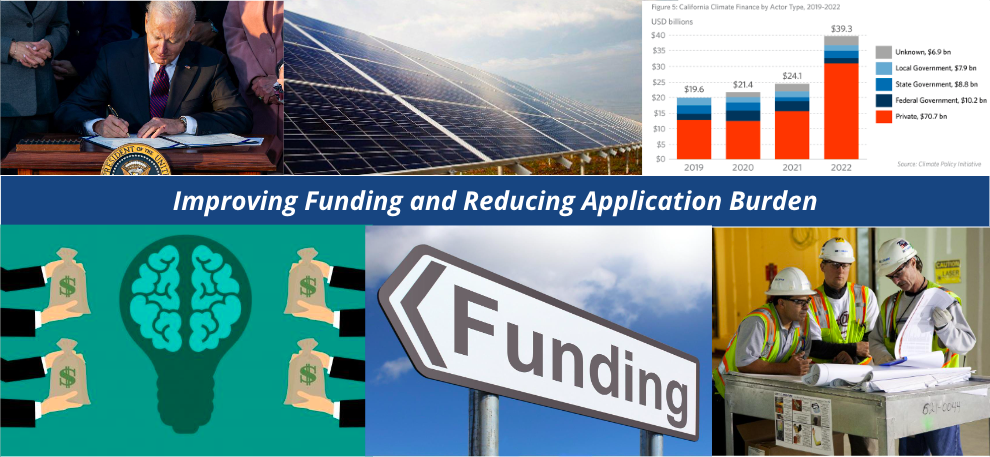March 14, 2024
Topic
Contribute to a Single Platform To Help State and Federal Agencies Drive Energy and Climate Action Through More Effective Investment in Local and Tribal Governments
Does it feel like you’ve been asked at least once a week how to best design and deploy funding over the last few years? I’m with you. In the various roles I’m lucky to play, including the Statewide Best Practices Coordinator for the California Climate and Energy Collaborative (CCEC) and consultant on several tribal initiatives, I often find myself in the space in between local and tribal communities and California State and federal agencies. I have participated in countless conversations and comment periods about how to get the right funding to the right places, people, and programs. All levels of government want to get it right, especially given the windfall of climate investments since 2020, and recent reality checks that we need much more investment to curb climate effects as quickly as possible.
At some point over these years, agency questions started repeating and solutions and themes started emerging. I needed a single place to track ideas that were being shared with units of every relevant agency, but not usually shared between them or used beyond a single grant program. And as calls for equity grew, the diligence on meaningful engagement grew. Somehow, great intentions for better engagement became unrelenting RFIs, listening sessions, and comment periods that none of us could keep up with and still do our day jobs, let alone actually apply for all these great funding opportunities. I’m not complaining – I remember the days when there were few external dollars available to address climate needs and fewer opportunities to work with agencies to shape programs. To ease engagement fatigue, address statewide barriers and solutions, improve program awareness, and ultimately help shape effective programs, CCEC created Local Energy Resources Network (LERN) and State/Local Energy & Climate Coordination (SLECC) meetings in collaboration with agencies like Strategic Growth Council, California Energy Commission and California Air Resources Board. These meetings allow us to facilitate regular homes for more streamlined and sustained collaborative conversations (rather than one-way, single issue engagements) between local and State/federal governments.
The great news is that some funding programs are improving, both in dollar amount and accessibility, and agency staff are continuously trying to develop better practices to streamline engagement, understand/address community needs, and reduce application burden. But it can be hard for State and federal staff to work beyond their own agencies. Meanwhile, bigger, bolder questions have occurred to me like: how much strained local and tribal capacity are we losing across the State in engaging in and pursuing these competitive funding opportunities (often unsuccessfully)? And: are small tweaks to programs enough? What other vehicles are there to deploy funding outside of cumbersome competitive grants? It became clear that there is more we can do as communities to help move things along more systematically.
After years of supporting State and federal agencies, listening to and advocating on behalf of communities, facilitating discussion between levels of government, reviewing hundreds of grant solicitations and guidelines, reading dozens of smart papers on how to improve funding, and compiling lots of ideas, I started to playfully threaten to release an emerging “manifesto” I have begun to refer to as Better Funding. So, here it is in working draft form.
It currently includes over 50 recommendations (with known best practice examples) for State and federal agencies to drive energy and climate action through more effective investment in local and tribal governments. In it, you’ll see operationable ideas that range from basic to bold for improving program design engagement, applications from the State on behalf of tribal and local governments, applications from tribal and local government, and post-award processes. It’s in draft form because this dish is admittedly not fully baked, and I’d love more thoughts on the solutions I classify as “Better,” “Better Yet,” “Better Still,” under the current paradigm of grant funding deployment, and “Ideal” where I suggest piloting a new, user-oriented vehicle for funding deployment.
A Sampling of Ideas in Better Funding:
A summary table of all ideas can be accessed here. |
I invite you to review this draft, offer additional ideas and best practices, request to sign on your support, or vehemently disagree with any of it. You can do so by emailing me (ahacker@civicwell.org), attending the March 14 State and Local Energy and Climate Coordination meeting on this topic (local and State government reps only), or attending my related presentation to the American Society of Adaptation Professional (ASAP) Policy Practices Member Group on April 5. Or you can invite me to present it to your network. I can’t promise this is the engagement to end all engagement, but you’d better believe I’ll be submitting this evolving single platform the next one hundred times this kind of input is requested of communities. Because there is one thing I now know for sure: fixing local and tribal funding is one of the most impactful things we can do to unlock our unique ability to protect communities from climate change.





